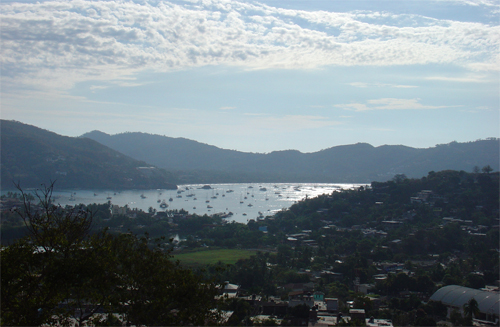
Zihuatanejo - Jan 24-31, 2006
I decided that it was finally time to head offshore and go after billfish with a fly so when Catherine told me she was heading to a training for a few weeks at the end of January I decided to go searching for a place that had good sailfish action that time of year. Zihuatanejo quickly became my choice because it was prime-time there and it was a new area of Mexico to explore. I booked the trip through Baja on the Fly and set up for three days of offshore fishing. I then went searching for a travel partner and my amigo Bill decided to tag along to check out the diving in the area and he went with Carlos Scuba on the days I fished. Of course, Alaska Air threw a wrench in the system as soon as we boarded the Boeing 737 at SeaTac. Our jet had a problem and we were moved off of it and herded to another plane which still didn't leave the gate for over two hours thus stranding us on Century Blvd outside the airport for the night, down went my first day of fishing on the 25th which would be spend flying from LAX to Zihuatanejo instead, bummer.
We finally did arrive and got set up at our home for the week, the Hotel Irma on Playa Madera. It was a pretty decent hotel, especially since all we did there was sleep, jump in the pool to cool off, and sit out hora de feliz each day from 5-6.
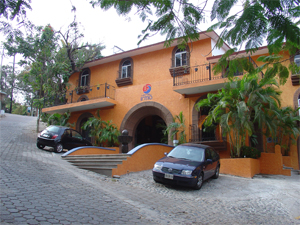 |
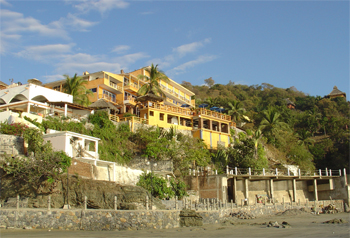 |
| Hotel Irma from the front | ... and from Playa Madera. Note the malecon walkway which goes to the pier in town along the water. |
On Thursday we headed to the pier and took the water ferry to Playa Las Gatas near the mouth of the bay. This is the best snorkeling beach (and the cleanest beach in general) in Zihuatanejo Bay and Bill wanted to check out the scuba place there. We hung out under a palapa all afternoon, grabbed some food, water, and cervezas and snorkeled around the rocks multiple times. The snorkeling was pretty good when you got to the deeper water near the boat landing and points out from there. I forgot my camera that day but you can see some photos of it at the Carlos Scuba web-site. We got some sun, possibly a bit too much but being sun-starved Seattleites we needed to just get the burn out of our systems.
Fishing
There were quite a few fishermen about since I quickly discovered I arrived in the middle of the Zihuatanejo Sailfest tournament and the arrival of several fly clubs so the boats were booked pretty much solid. The fishing had also evidently slowed down the week before from raising 10 or more fish per day to raising 2-4 fish per day. Still, I had my two days of offshore fishing left and booked a third day to do some inshore fishing on a panga. I arrived Friday at the pier at 6:00 a.m. and set out to find my boat, the Gaby, el capitan Margarito, and his mate Roberto.
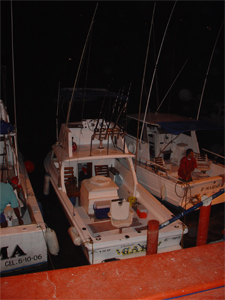 |
 |
| La Gaby | The sunrise motoring out of Zihua Bay |
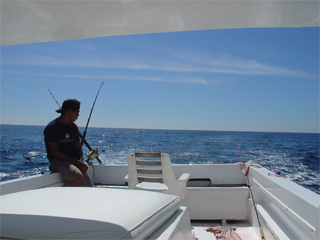 |
|
|
My view most of the day |
|
That day we rose 3 sailfish and only one got close enough to cast to and it ignored the fly for three casts. Margarito had asked me if it was OK to throw the fish a baited circle hook should it refuse the fly and I agreed since I'd never even landed a sailfish so after three strikes he tossed out the real deal. The fish took the bait pretty quickly and the fight was on. My first sail was an 80 lbs. fish that we quickly released.
The next day I was off again on the Gaby. Again we rose three fish for the day and the first one behaved just like the one yesterday, it refused the fly after 4 casts and in went the bait, on went the fish.
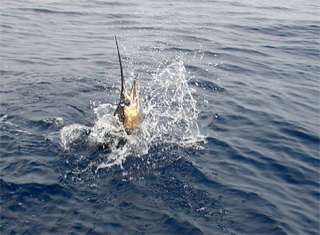 |
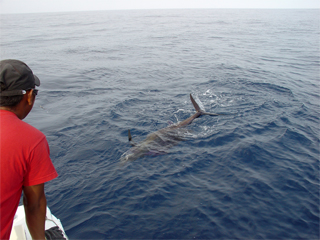 |
| Thrashing around close to the boat, this thing was starting to look dangerous | Ready to land |
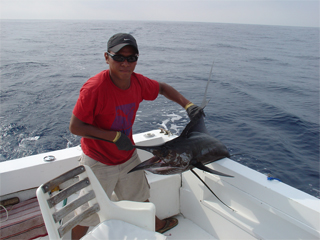 |
|
|
Roberto and my pez vela |
|
The next fish up refused both the fly and bait. I then switched to a fly that made a bit more noise because I noticed that the fish tended to follow the teaser while it was chugging on the surface. The third fish came up, I tossed the Cam Sigler popper at it and on the 4th cast he took it, I set the hook, and the next thing I knew my line and backing was moving off at high speed. The fish was about 150 yards out when he hit the surface and went greyhounding, leaping, and tailwalking about another 100 yards. On the 20th or so major leap the fly came out. Here is the only picture I have of the fish, it was about 3 football fields away by the time we shot it.

We didn't get another shot the rest of the day at a sail so I guess I'm going to have to try again. Still, I landed two fish on gear and hooked up my first one on a fly rod in only two days of fishing so it went pretty well.
On Monday I went out with Miguel and his panga, the Tarpon. I wanted to check out the inshore fishing for a change and got to cast my 9-weight instead of the 14-weight. We hit some rocks south of the bay at the next point and I got a few dozen fish - some nice jacks, cabrillo, and other rock-fish. We then went out to open water along a scum line and searched for barrilette (black skipjack tuna). We found a school of them tearing up bait on the surface and spent our last hour positioning the panga for decent casts. The fish were aggressive and took a #2 Chartreuse Clousers and put up one heck of a fight on the 9-weight rod. I didn't get any fish pictures that day but here's another panga fishing rocks and a shot of Miguel and the Tarpon. It was a fun day and I spent it casting and practicing mi español con Miguel.
 |
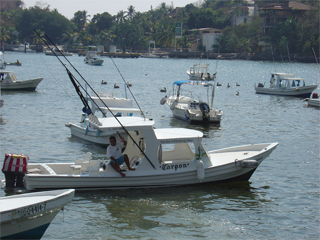 |
| Typical inshore fishing waters | Miguel and the Tarpon |
Zihuatanejo
Zihuatanejo is a great little town of about 80,000 people. El Centro is right on the bay with and extends on the flat plain there. Then neighborhoods go up the hills and into a couple of connecting valleys. Once you get off the waterfront and the hotel zone at Playa Madera (I never made it to the trendier Playa La Ropa hotel zone) it is mostly a Mexican town and you can walk around and never see another gringo. Bill and I roamed the town one morning before heading out to Playa Linda and Isla Ixtapa north of the mini-Cancun-like resort area of Ixtapa. Here are photos of the walk-about in Zihuatanejo.
 |
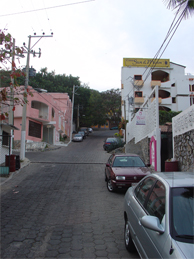 |
 |
| Heading down the hill to town | looking back up the hill | The Iglesia |
 |
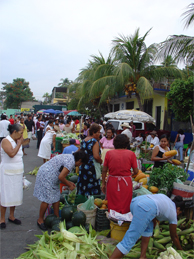 |
 |
| The clock tower at the main circulo | The street market | More market |
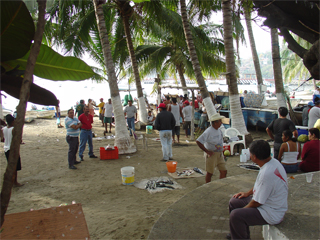 |
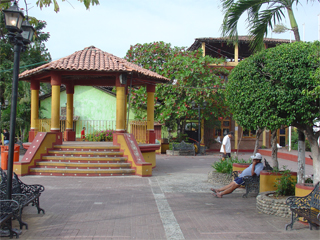 |
|
| The fish market by the pier | The zocolo on the waterfront | |
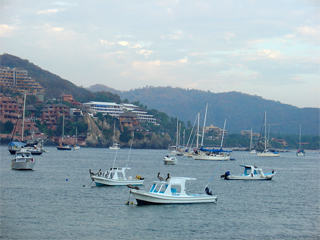 |
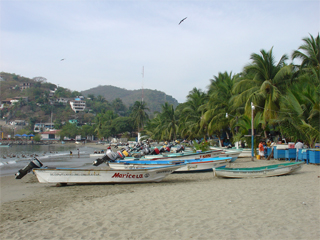 |
|
| The panga fleet for gringos and some sailboats | The local fishermen's panga fleet on the beach | |
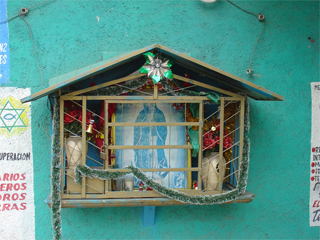 |
||
| The alter at the Mercado de Artesinias | ||
Food is cheap if you stay off the waterfront strip and the more expensive Playa Madera and Playa La Ropa places. We only once spent more than $100 pesos each ($10USD) on food for dinner and managed to get by on about $250 pesos/day on food each and that included beers, the occasional michelada and the hora de feliz margaritas. We can definitely recommend La Casa Cafe for breakfast/espresso drinks on the way from Playa Madera hotels to El Centro. For dinner Los Braseros was our favorite, they had tacos pastor for Bill, great fish mole for me and even vegetarian food which was pretty hard to find anywhere else so we ate there two nights. We also hit Cafeteria Nueva Zealandia and the little Mariscos place next door to it. We splurged one night and went to Sirena Gorda (Fat Mermaid) on the waterfront which cost more than 2 days of eating in one meal. On the waterfront we avoided all the hawkers, especially the guy who was convinced Bill and I really wanted some marijuana instead of dinner each time we walked by, and went to the little place at the end which was quiet and had a great view of Playa Municipal. They had great tacos pescado, a menu totally in Spanish, and no English was spoken there.
 |
|
The quite place at the end of the beach strip |
Getting around is also cheap, the buses in town run for about $4 pesos to get anywhere. Even the bus to Playa Linda was only $15 pesos. Taxis are more expensive and the pricing is pretty random but at 6:00 a.m. you don't have much choice. The good news is that you can walk the whole town with no trouble at all and only need a taxi to get to the pier in the dark in the mornings and to get to and from the airport.
The people in Zihuatanejo are all friendly and willing to help you out or just sit and chat with you. Each day on my walk home from the pier I got asked by at least 2-3 locals how the fishing was, who I fished with, etc... One morning I spent some time with two young girls at a t-shirt shop teaching them simple English phrases because they asked me and wanted to learn how to say a bit more in English. They are not taught any English in school, they pick it up on their own on the street, from books, and from movies. It was very fun teaching them the English names of the fish on their shirts and how to say simple things like "I speak a little English". Some English is common in the hotels and with some boat captains and taxi drivers but Spanish dominates. Many shop and restaurant workers in the small places speak very little to no English so knowing basic Spanish helps a lot if you want to get off the tourist zones.
Playa Linda/Isla Ixtapa
On Sunday we rode the bus to Playa Linda north of Ixtapa to walk the bike trail around the lagoon and to take the water taxi to Isla Ixtapa to snorkel and hang out at yet another palapa.
The trail system in the Laguna de Ixtapa is a nice walk and you have a chance to see many birds and crocodillos.
 |
 |
| A typical crocodillo | |
 |
 |
| Laguna de Ixtapa |
After our short walk (it was hot) we headed to the water taxi and Playa Coral on Isla Ixtapa. The snorkeling at this beach was amazing. Just offshore you could see enormous angel fish, schools of jacks, eels, lots of small fish, etc... It was one of the better snorkeling places I'd been. In fact, you could stand on the beach and watch fish swim in the deep trough right at your feet.
 |
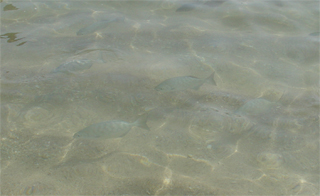 |
| The scene at Playa Coral | Fish in the surf at your feet |
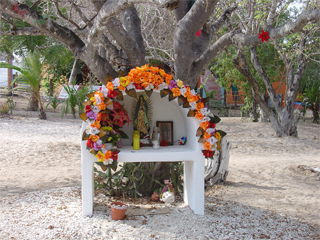 |
|
|
The alter at the beach |
|
Escuela Netzahualcoyotl
On my last day i went to visit the Netza school which was located up the hill from town in a very poor neighborhood. From there you really see the class differences in this town. At Playa Madera and on the waterfront you have very wealthy gringos from all over the developed world and the wealthy Mexicans who own some of the establishments. Next seems to be the boat captains and boat owners and their families, you see a lot of local kids with cell phones just like in the US. Next comes the average Mexican family that work in restaurants and hotels and are poor by US standards. Then you climb the hill to the Colonia Primer Paso neighborhood and you see the real poor of Zihuatanejo - this is where the gente indigenia (indigenous people) and impoverished people live. Some of the families here speak no Spanish and the children cannot attend the regular public schools because of that and the Netza school takes them in to teach them Spanish as well as the regular primary school curriculum.
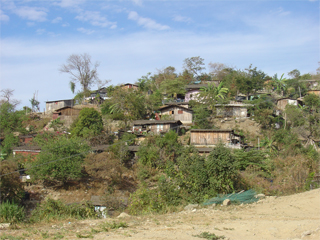 |
|
The Colonia Primer Paso neighborhood |
I learned of the Netza school project about a year ago when a friend of Catherine's who had left Seattle to teach there and live in Zihuatanejo came back to hold a benefit event for the school here. I decided that when I made it to Zihua that I would get to the school to learn more about it. I showed up in the morning and met Lisa Martin a US volunteer and a group of other volunteers from Maine, Massachusetts and Seattle. There Lisa set up an eye-exam clinic for the day and we administered simple exams to the students. Luckily the students learn Spanish in the school and we had enough volunteers who spoke Spanish to handle interviewing and administering the test while others were the pointers at the eye charts or helped funnel children to the proper table for their exam.
 |
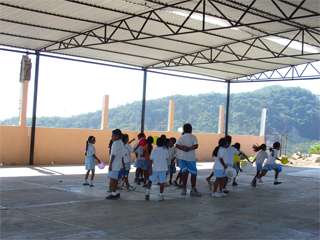 |
| The Netza School | The play court |
 |
 |
| Students waiting for their exams | Interviewing one of the students |
I don't think I've ever seen kids that were so excited as these children when Lisa pulled up. They were all willing to help carry chairs to the room to set up when I entered the classroom to ask for some assistance and they all smiled and said <<Buenos Dias>> when they saw you the first time. A balloon became a prized possession. Even in this neighborhood I saw friendliness that I rarely see in Seattle, people greeted me on the street, when someone entered the bus everyone on the bus greeted them stranger or not. I can understand now why some of the latino friends I have made in this area miss the closeness of their home cultures when they come to America.
I couldn't stay the whole day since I had to get back to the hotel to check out at 1 p.m. and head to the airport and the flight back to Seattle.